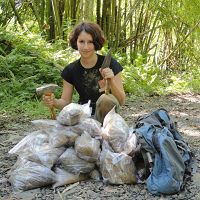Stone et al., 2015
Parent material and vegetation influence bacterial community structure and nitrogen functional genes along deep tropical soil profiles at the Luquillo Critical Zone Observatory
Stone, M.M., Kan, J.J., Plante A.F. (2015)
Soil Biology & Biochemistry
-
Luquillo, GRAD STUDENT
-
Christina, Luquillo, INVESTIGATOR, COLLABORATOR
Abstract
Microbial communities mediate every step of the soil nitrogen cycle, yet the structure and associated nitrogen cycle functions of soil microbial communities remain poorly studied in tropical forests. Moreover, tropical forest soils are often many meters deep, but most studies of microbial nitrogen cycling have focused exclusively on surface soils. The objective of our study was to evaluate changes in bacterial community structure and nitrogen functional genes with depth in soils developed on two contrasting geological parent materials and two forest types that occur at different elevations at the Luquillo Critical Zone Observatory in northeast Puerto Rico. We excavated three soil pits to 140 cm at four different sites representing the four soil × forest combinations (n = 12), and collected samples at ten-centimeter increments from the surface to 140 cm. We used bacterial 16S rRNA gene-DGGE (denaturant gradient gel electrophoresis) to fingerprint microbial community structures, and quantitative PCR to measure the abundance of five functional genes involved in various soil nitrogen transformations: nifH (nitrogen fixation), chiA (organic nitrogen decomposition), amoA (ammonia oxidation), nirS (nitrite reduction) and nosZ (nitrous oxide reduction). Multivariate analyses of DGGE fingerprinting patterns revealed differences in bacterial community structure across the four soil × forest types that were strongly correlated with soil pH (r = 0.69, P < 0.01) and nutrient stoichiometry (r2 ≥ 0.36, P < 0.05). Across all soil and forest types, nitrogen functional genes declined significantly with soil depth (P < 0.001). Denitrification genes (nirS and nosZ) accounted for the largest proportion of measured nitrogen functional genes. Measured nitrogen functional genes were positively correlated with soil carbon, nitrogen and phosphorus concentrations (P < 0.001) and all genes except amoA were significantly more abundant in the Inceptisol soil type compared with the Oxisol soil type (P < 0.03). Greater abundances and a stronger vertical zonation of nitrogen functional genes in Inceptisols suggest more dynamic nitrogen transformation processes in this soil type. As the first study to examine bacterial nitrogen functional gene abundances below the surface 20 cm in tropical forest soils, our work provides insight into how pedogenically-driven vertical gradients control the nitrogen-cycling capacity of soil microbial communities. While previous studies have shown evidence for redox-driven hotspots in tropical nitrogen cycling on a watershed scale, our study corroborates this finding on a molecular scale.
Citation
Stone, M.M., Kan, J.J., Plante A.F. (2015): Parent material and vegetation influence bacterial community structure and nitrogen functional genes along deep tropical soil profiles at the Luquillo Critical Zone Observatory. Soil Biology & Biochemistry . DOI: 10.1016/j.soilbio.2014.10.019
 This Paper/Book acknowledges NSF CZO grant support.
This Paper/Book acknowledges NSF CZO grant support.
Explore Further


